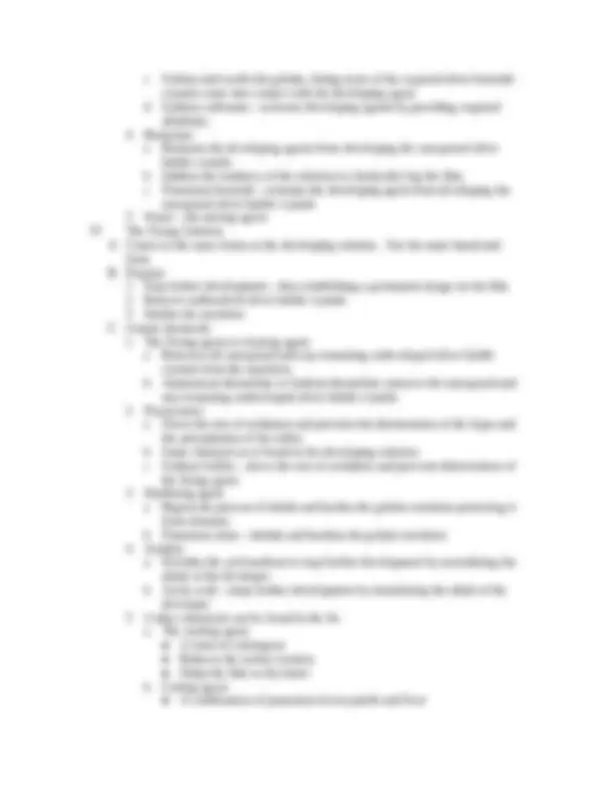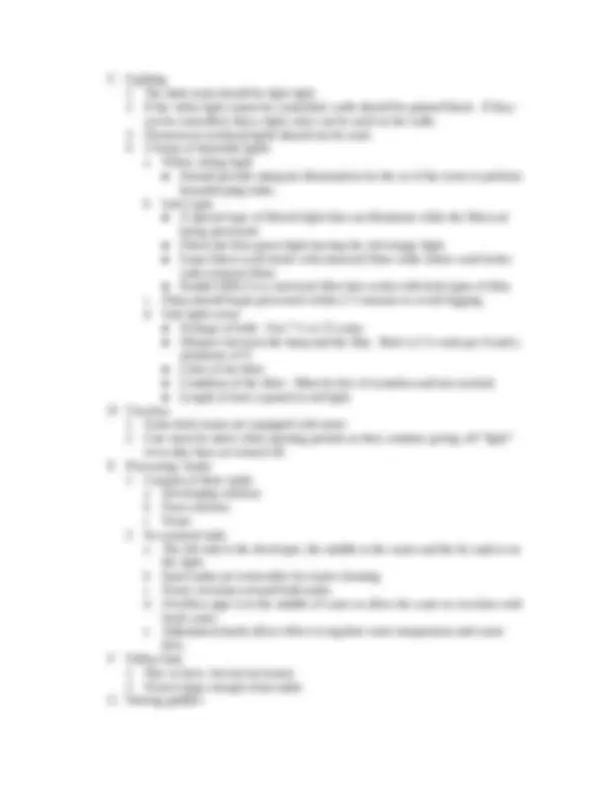





Study with the several resources on Docsity

Earn points by helping other students or get them with a premium plan


Prepare for your exams
Study with the several resources on Docsity

Earn points to download
Earn points by helping other students or get them with a premium plan
Community
Ask the community for help and clear up your study doubts
Discover the best universities in your country according to Docsity users
Free resources
Download our free guides on studying techniques, anxiety management strategies, and thesis advice from Docsity tutors
Material Type: Exam; Class: Dental Radiography; Subject: Dental Assisting; University: Front Range Community College; Term: Unknown 1989;
Typology: Exams
1 / 7

This page cannot be seen from the preview
Don't miss anything!




At the completion of this lesson, the student will with at least 70% on a written and/or oral exam and 100% accuracy on a performance evaluation:
c Exposes the silver halide crystals to the chemical of the developer. 3 Rinsing a Second step b Purpose To remove as much of the alkaline developer as possible Preserves the acidity of the fixer Prolongs the life of the fixer solution 4 Fixer a Third Step b Purpose--To remove the undeveloped silver from the film emulsion 5 Washing a The fourth step b Purpose—to remove all remaining chemical left on the film 6 Drying a Final Step b Purpose—to prolong the life of the radiograph c Can be either air dryad or in a cabinet III The Developer Solution A Can be obtained in three forms 1 Powder 2 Ready to use liquid 3 Liquid concentrate B Main purpose is to convert the silver halide crystals into metallic silver grains. C Contains 4 main chemicals that mixed with distilled water, ideally. 1 Developing agent a Also known as the reducing agent b Reduces the exposed silver halide to metallic silver c Has NO effect on the unexposed silver halide crystals d Contains 2 main chemicals Hydroquinone Reduces exposed silver halide to black metallic silver Slowly builds up black tones and contrast. Elon Reduces exposed silver halide crystals Quickly builds up gray tones e Both chemicals are extremely sensitive to temperatures. The higher the temperature, the faster the developing processing. 2 Preservative a Protects the developing agents by slowing down the rapid oxidation rate of the developer b Sodium Sulfite—prevents the rapid oxidation of the developing agents. 3 Activator a Also called the alkalizer b Provides the necessary alkaline medium required by the developing agents.
Can be used in an emergency to lighten films that have been accidentally overexposed or overdeveloped. Should only be used when it is inadvisable or impossible to retake a film. V Changing solutions A Depending on type of processing, solution is changed from every 2-4 wks. B Useful solution is determined by 1 The original quality or concentration of the solution 2 The freshness of solution 3 Number of films processed 4 Contamination of the chemicals. C Developer solution is lost to: 1 Evaporation 2 Drops of solution adhering to the film and/or film hangers D Fixer solution is lost to: 1 Dilution from the rinse water 2 Evaporation E Replenisher 1 A super concentrated solution of either developer or fixer 2 First sign of exhaustion in the developing solution is a “light” film with a thin image 3 First sign of exhaustion in the fixer solution is the film takes longer than 2 minutes to “clear”. F Daily check solutions to make sure that there is enough solution for the day. This should also be done frequently through out the day. VI The Darkroom A Purpose—to provide a dark area where x-rays can be safely handled and processed. B Requirements 1 Should be equipped with the correct type of lightening 2 Should be well ventilated 3 Ideally, the door should have either a lock or a revolving door to prevent staff from accidentally walking in during the processing. 4 Equipment a Overhead white light b Darkroom safelight c Viewbox d Processing tanks e Utility sink f Stirring paddles g Timer h Thermometer i Film hangers, drying racks j Electric fan k Wastebasket, lead foil container and biohazard container l Ample storage for x-ray supplies.
C Lighting 1 The dark room should be light tight 2 If the white light cannot be controlled, walls should be painted black. If they can be controlled, then a light color can be used on the walls. 3 Fluorescent overhead lights should not be used. 4 2 forms of desirable lights a White ceiling light Should provide adequate illumination for the sz of the room to perform housekeeping tasks. b Safe Light A special type of filtered light that can illuminate while the films are being processed. Filters the blue-green light leaving the red-orange light. Some filters work better with intraoral films while others work better with extraoral films Kodak GBX-2 is a universal filter that works with both types of film. c Films should begin processed within 2 ½ minutes to avoid fogging. d Safe light errors Wattage of bulb. Use 7 ½ or 15 watts Distance between the lamp and the film. Rule is 2 ¼ watts per ft and a minimum of 4’ Color of the filter Condition of the filter. Must be free of scratches and not cracked. Length of time exposed to red light. D Viewbox 1 Some dark rooms are equipped with some 2 Care must be taken when opening packets as they continue giving off “light” even after they are turned off. E Processing Tanks 1 Consists of three tanks a Developing solution b Fixer solution c Water 2 In a manual tank; a The left side is the developer, the middle is the water and the fix tank is on the right. b Insert tanks are removable for easier cleaning. c Water circulates around both tanks. d Overflow pipe is in the middle of water to allow the water to circulate with fresh water. e Adjustment knobs allow office to regulate water temperature and water flow. F Utility Sink 1 Nice to have, but not necessary 2 Want it large enough clean tanks G Stirring paddles
C Check temperature of developer and water (developer solution temperature is more important) 1 68 ° F for 5 minutes developing time 2 65 ° F for 7 minutes developing time 3 80°F for 3 minutes developing time D Label film hanger E Close and lock darkroom door F Unwrap film packet and drop G Remove gloves H Clip film to hangers I Set timer J Immerse films into developer, shaking gently activate timer K Remove films from developer and drain L Rinse films M Immerse into fixer, shaking gently N Set and activate timer O Remove from fix and allow to drain P Wash films for 20 minutes under running water Q Dry films R Mount films S Other nice to knows 1 Quick read a X-ray is needed immediately for RCT or other emergency b Also called a “wet” read c After 2 minutes, the film is removed from the fixer rinsed and read at chairside d After seeing the film, the film is placed in the fixer solution for the remaining time, washed and then dried. 2 Films to be mounted and put away DAILY 3 Clean countertops free of solution or water 4 Rinse hangers if film not rinsed for 20 minutes on same rack 5 Remove pt. identification at the end of the day or when film(s) are mounted T Turn water off at end of day along with the light. IX Rapid Processing Procedure